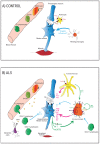Motor neuron-immune interactions: the vicious circle of ALS
- PMID: 20552235
- PMCID: PMC3511247
- DOI: 10.1007/s00702-010-0429-0
Motor neuron-immune interactions: the vicious circle of ALS
Abstract
Because microglial cells, the resident macrophages of the CNS, react to any lesion of the nervous system, they have for long been regarded as potential players in the pathogenesis of several neurodegenerative disorders including amyotrophic lateral sclerosis, the most common motor neuron disease in the adult. In recent years, this microglial reaction to motor neuron injury, in particular, and the innate immune response, in general, has been implicated in the progression of the disease, in mouse models of ALS. The mechanisms by which microglial cells influence motor neuron death in ALS are still largely unknown. Microglial activation increases over the course of the disease and is associated with an alteration in the production of toxic factors and also neurotrophic factors. Adding to the microglial/macrophage response to motor neuron degeneration, the adaptive immune system can likewise influence the disease process. Exploring these motor neuron-immune interactions could lead to a better understanding in the physiopathology of ALS to find new pathways to slow down motor neuron degeneration.
Figures

References
-
- Ajami B, Bennett JL, Krieger C, Tetzlaff W, Rossi FM. Local self-renewal can sustain CNS microglia maintenance and function throughout adult life. Nat Neurosci. 2007;10:1538–1543. - PubMed
-
- Alexianu ME, Kozovska M, Appel SH. Immune reactivity in a mouse model of familial ALS correlates with disease progression. Neurology. 2001;57:1282–1289. - PubMed
-
- Almer G, Vukosavic S, Romero N, Przedborski S. Inducible nitric oxide synthase up-regulation in a transgenic mouse model of familial amyotrophic lateral sclerosis. J Neurochem. 1999;72:2415–2425. - PubMed
-
- Almer G, Guegan C, Teismann P, Naini A, Rosoklija G, Hays AP, Chen C, Przedborski S. Increased expression of the pro-inflammatory enzyme cyclooxygenase-2 in amyotrophic lateral sclerosis. Ann Neurol. 2001;49:176–185. - PubMed
-
- Andersson PB, Perry VH, Gordon S. The kinetics and morphological characteristics of the macrophage-microglial response to kainic acid-induced neuronal degeneration. Neuroscience. 1991;42:201–214. - PubMed
Publication types
MeSH terms
LinkOut - more resources
Full Text Sources
Medical
Miscellaneous

